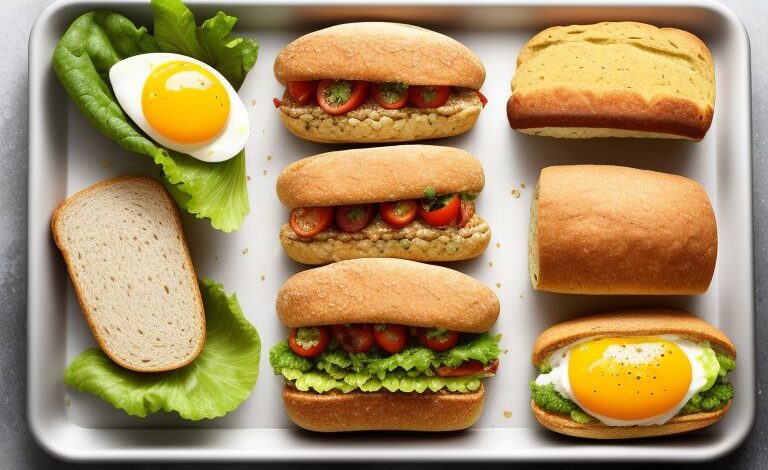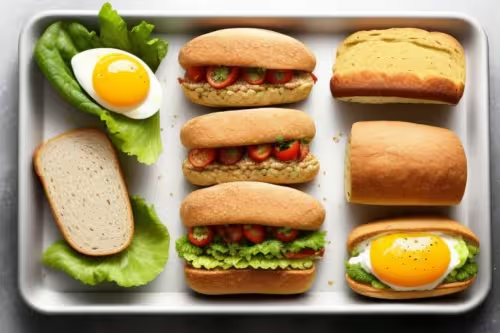
Bread has been a staple in diets around the world for centuries. From sandwiches to toast, it's a convenient and versatile food. However, many people are now seeking healthier alternatives to bread, whether due to dietary restrictions, weight management goals, or a desire for more nutrient-dense options.
In this article, we'll explore some of the best healthy alternatives to bread that can fit into a variety of diets, from gluten-free to low-carb. Whether you're looking for something to replace your morning toast or want a new base for your favorite sandwich, these options are delicious and nutritious.

Why Look for Alternatives to Bread?
Before diving into the alternatives, it’s important to understand why someone might want to replace bread in their diet. Here are a few common reasons:
1. Gluten Sensitivity or Celiac Disease
Gluten is a protein found in wheat, barley, and rye. For those with gluten sensitivity or celiac disease, consuming bread can lead to uncomfortable symptoms such as bloating, diarrhea, and fatigue. As a result, many seek gluten-free alternatives.
2. Low-Carb or Keto Diet
Bread is typically high in carbohydrates, which can be a concern for those following low-carb or ketogenic (keto) diets. These diets focus on reducing carb intake to promote fat burning and weight loss, making traditional bread less suitable.
3. Weight Management
Bread, especially white bread, can be high in calories and low in nutrients, leading to weight gain if consumed in excess. People looking to manage their weight might seek alternatives that are lower in calories and higher in fiber and protein.
4. Nutrient-Dense Diet
Some individuals aim to maximize their nutrient intake by choosing foods that are rich in vitamins, minerals, and other essential nutrients. Bread alternatives can offer more nutritional value, with higher fiber, protein, and healthy fats.
Top Healthy Alternatives to Bread
If you're ready to swap out bread for something healthier, here are some of the best alternatives to consider:
1. Lettuce Wraps
Lettuce wraps are a popular alternative to bread, especially for those on low-carb or gluten-free diets. They’re crisp, refreshing, and provide a satisfying crunch without the carbs.
- Best for: Sandwiches, burgers, wraps.
- Nutritional benefits: Low in calories and carbs, high in vitamins A and K.
- How to use: Use large lettuce leaves (such as romaine or iceberg) as a wrap for your favorite sandwich fillings, like turkey, avocado, or chicken salad.
2. Cauliflower Bread
Cauliflower has become a go-to ingredient for low-carb diets, and cauliflower bread is a fantastic alternative to traditional bread. It’s gluten-free, low in carbs, and can be used in a variety of dishes.
- Best for: Toast, sandwiches, pizza crust.
- Nutritional benefits: Low in carbs, high in fiber, rich in vitamins C and K.
- How to use: Mix riced cauliflower with eggs and cheese, shape into a flatbread, and bake. Use it as a base for sandwiches or as a pizza crust.
3. Sweet Potato Slices
Sweet potato slices are a nutrient-dense alternative to bread, offering a satisfying sweet flavor and a good source of complex carbohydrates. They’re especially popular in paleo and gluten-free diets.
- Best for: Toast, open-faced sandwiches.
- Nutritional benefits: High in fiber, vitamins A and C, and antioxidants.
- How to use: Slice sweet potatoes into 1/4-inch thick pieces, toast them in the oven or toaster, and top with avocado, nut butter, or eggs.
4. Rice Cakes
Rice cakes are a light and crunchy alternative to bread, making them a great base for a variety of toppings. They’re gluten-free and low in calories, making them suitable for weight management diets.
- Best for: Snacks, open-faced sandwiches.
- Nutritional benefits: Low in calories, gluten-free, can be made from whole grains.
- How to use: Top rice cakes with hummus, smoked salmon, nut butter, or fresh fruits for a quick and healthy snack.
5. Coconut Flour Flatbread
Coconut flour is a popular gluten-free alternative to wheat flour, and it can be used to make delicious flatbreads. This option is low in carbs and high in fiber, making it suitable for keto and paleo diets.
- Best for: Sandwiches, wraps, snacks.
- Nutritional benefits: Low in carbs, high in fiber, contains healthy fats.
- How to use: Mix coconut flour with eggs, water, and seasoning, then cook in a skillet to create a soft and flexible flatbread.
6. Portobello Mushrooms
Portobello mushrooms are a meaty and flavorful alternative to bread, perfect for those looking to cut carbs while still enjoying a hearty meal. They’re naturally gluten-free and packed with nutrients.
- Best for: Burgers, sandwiches.
- Nutritional benefits: Low in carbs, rich in antioxidants, high in vitamins B and D.
- How to use: Grill or roast portobello mushroom caps and use them as buns for burgers or sandwiches.
7. Eggplant Slices
Eggplant slices are a versatile and nutrient-dense alternative to bread. They’re perfect for low-carb diets and can be grilled, baked, or roasted to create a delicious base for various toppings.
- Best for: Open-faced sandwiches, snacks.
- Nutritional benefits: Low in calories, high in fiber, contains antioxidants.
- How to use: Slice eggplant into rounds, cook until tender, and use as a base for toppings like tomato, mozzarella, and basil.
8. Almond Flour Bread
Almond flour is another popular gluten-free alternative, and it can be used to make a nutrient-rich bread that’s perfect for those on a low-carb or keto diet. It’s high in healthy fats and protein, making it a filling option.
- Best for: Toast, sandwiches, snacks.
- Nutritional benefits: Low in carbs, high in protein, contains healthy fats.
- How to use: Use almond flour to bake bread loaves, muffins, or flatbreads, and enjoy with your favorite spreads and fillings.
9. Nori Sheets
Nori sheets, made from seaweed, are a unique and healthy alternative to bread. They’re low in calories and carbs, making them ideal for low-carb and gluten-free diets, and they add a delightful umami flavor to your meals.
- Best for: Wraps, sushi rolls, snacks.
- Nutritional benefits: Low in calories, rich in iodine and other minerals, contains antioxidants.
- How to use: Use nori sheets to wrap fillings like tuna salad, avocado, and veggies, or enjoy them as a snack with a sprinkle of sesame seeds.
10. Cucumber Slices
Cucumber slices offer a refreshing and hydrating alternative to bread. They’re perfect for low-carb, gluten-free, and weight management diets, and they add a crisp texture to your meals.
- Best for: Snacks, open-faced sandwiches.
- Nutritional benefits: Low in calories, high in water content, rich in vitamins K and C.
- How to use: Slice cucumbers into rounds or long strips, and top with your favorite spreads and toppings like hummus, smoked salmon, or feta cheese.
How to Choose the Right Alternative for You
When selecting a healthy alternative to bread, it’s important to consider your dietary needs and preferences. Here are some factors to keep in mind:
1. Dietary Restrictions
If you have specific dietary restrictions, such as gluten sensitivity or a need to reduce carbs, opt for alternatives that align with your needs. For example, lettuce wraps and cauliflower bread are great for low-carb diets, while rice cakes and almond flour bread are excellent gluten-free options.
2. Nutritional Goals
Consider your nutritional goals when choosing a bread alternative. If you’re looking to increase your fiber intake, options like sweet potato slices, eggplant, and coconut flour flatbread are ideal. If protein is a priority, almond flour bread and Portobello mushrooms are great choices.
3. Flavor and Texture Preferences
Different alternatives offer varying flavors and textures. Lettuce wraps and cucumber slices provide a refreshing crunch, while almond flour bread and cauliflower bread offer a more traditional bread-like texture. Choose what appeals to your taste buds and complements your meals.
4. Versatility
Some alternatives are more versatile than others. For example, coconut flour flatbread and cauliflower bread can be used in a wide range of dishes, from sandwiches to pizza crusts, making them excellent choices if you want a multipurpose option.
Embrace Healthy Alternatives to Bread
Whether you’re looking to cut back on carbs, avoid gluten, or simply add more nutrients to your diet, there are plenty of healthy alternatives to bread that can fit your lifestyle. From crisp lettuce wraps to hearty cauliflower bread, these options offer delicious and nutritious ways to enjoy your favorite meals without the drawbacks of traditional bread.
By experimenting with these alternatives, you can discover new flavors and textures that not only satisfy your cravings but also support your health goals. So, next time you’re planning a meal, consider swapping out the bread for one of these healthy alternatives and enjoy the benefits of a more balanced diet.



